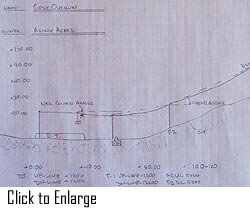
|
|
|
|
Home : Technical : Facts & Figures : Haulrope : Negative Cord Angle  Negative Cord Angle:
Negative Cord Angle:By: Ryan B What we are looking at is a negative cord angle of the haul rope. As a lift gets designed, each tower cord angle has a critical relationship with the tower below and above it. For a full load condition on the up-line side of this tower, the haul rope will want to sag away from the tower towards the ground; the tower is lowered so the minimum design sheave weight is maintained to prevent the haul rope from moving out of its groove, (quite common on some lifts). In effect this tower is preloaded so it can produce the proper sheave load in all loaded conditions. It's possible this design could also be accomplished by putting a compression style assembly at this tower; however this would complicate the tower design as it would have to be built to accept both positive and negative loads. In each area there are given limits and recommendations for corrections if the limit is exceeded. Haul rope actual safety factor in ski lifts is quite high compared to other wire rope uses. To my knowledge no haul rope has broken while in normal use at a ski area. This style of tower is an elegant engineering solution - the negative load that the haul rope imparts on the tower is canceled out by the weight of the assemblies and tower components. No support to the ground is needed. The negative cord angle also preloads the assembly that is in the terminal, this sheave load can become negative when a large load passes the center pivot line of the tower in the image. Again remember each tower has a close relationship with the towers next to it. Top drive, bottom tension lifts will induce extreme dynamic negative loads on down line terminal assemblies. The drive system will also lift the counterweight at it tries to pull the load uphill. YAN has many towers that were similar to image but the tower is hinged at the terminal cross arm. The tower just floats on the haul rope! This provides a constant weight on the haul rope regardless of loaded condition. Definitions: |
Home : About Skilifts.org : Donate : Privacy Policy : Terms of Use
All logos and trademarks on this site are property of their respective owner.
© Copyright 2002-2004 by Skilifts.org -- All Rights Reserved.
Hosted by NW-Hosting.com